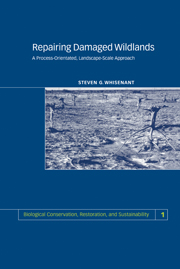Book contents
- Frontmatter
- Contents
- Preface
- Acknowledgments
- 1 Wildland degradation and repair
- 2 Assessing damage to primary processes
- 3 Repairing damaged primary processes
- 4 Directing vegetation change
- 5 Selecting plant materials
- 6 Site preparation and seedbed management
- 7 Planting
- 8 Planning repair programs for wildland landscapes
- Literature cited
- Index
7 - Planting
Published online by Cambridge University Press: 03 December 2009
- Frontmatter
- Contents
- Preface
- Acknowledgments
- 1 Wildland degradation and repair
- 2 Assessing damage to primary processes
- 3 Repairing damaged primary processes
- 4 Directing vegetation change
- 5 Selecting plant materials
- 6 Site preparation and seedbed management
- 7 Planting
- 8 Planning repair programs for wildland landscapes
- Literature cited
- Index
Summary
Introduction
Planting seed, plant parts, or entire plants are common techniques for introducing species into repair sites. Direct seeding puts seed into the soil with some control over depth, density, and spacing. Broadcasting seeding scatters seed over the soil surface. Planting entire plants (wildings, containerized seedlings, or bare-root seedlings) or plant parts (stolons, rhizomes, bulbs, corms, or stem sections) is more reliable in harsh environments, but has greater expense. Effective planting strategies contain information on the most effective planting time, planting rate, planting depth, and the most appropriate equipment. The goal is to increase establishment success by placing the plants or seed in the soil at the optimum time and under the ideal conditions.
Direct seeding
Direct seeding has several advantages compared with transplanting. Most repair programs prefer seed to seedlings because seed are less expensive, easily stored and transported, and more readily collected or purchased. This flexibility, and the relatively low cost, make direct seeding the preferred planting method for many situations. It is particularly useful where access, terrain, or soil conditions make transplanting whole plants difficult, too expensive, or impossible (Barnett & Baker, 1991). When direct seeding, the most important considerations involve seed preparation, planting time, planting depth, seeding rate, and selecting the most appropriate seeding method.
Seed preparation
Many species require some type of seed treatment before planting. These treatments break natural dormancy mechanisms that delay germination, or inoculate the seed with bacteria to encourage symbiotic, nitrogen-fixing relationships.
BREAKING SEED DORMANCY
Even with ideal seedbed conditions, some seed germinate slowly or not at all after planting.
- Type
- Chapter
- Information
- Repairing Damaged WildlandsA Process-Orientated, Landscape-Scale Approach, pp. 198 - 227Publisher: Cambridge University PressPrint publication year: 1999



